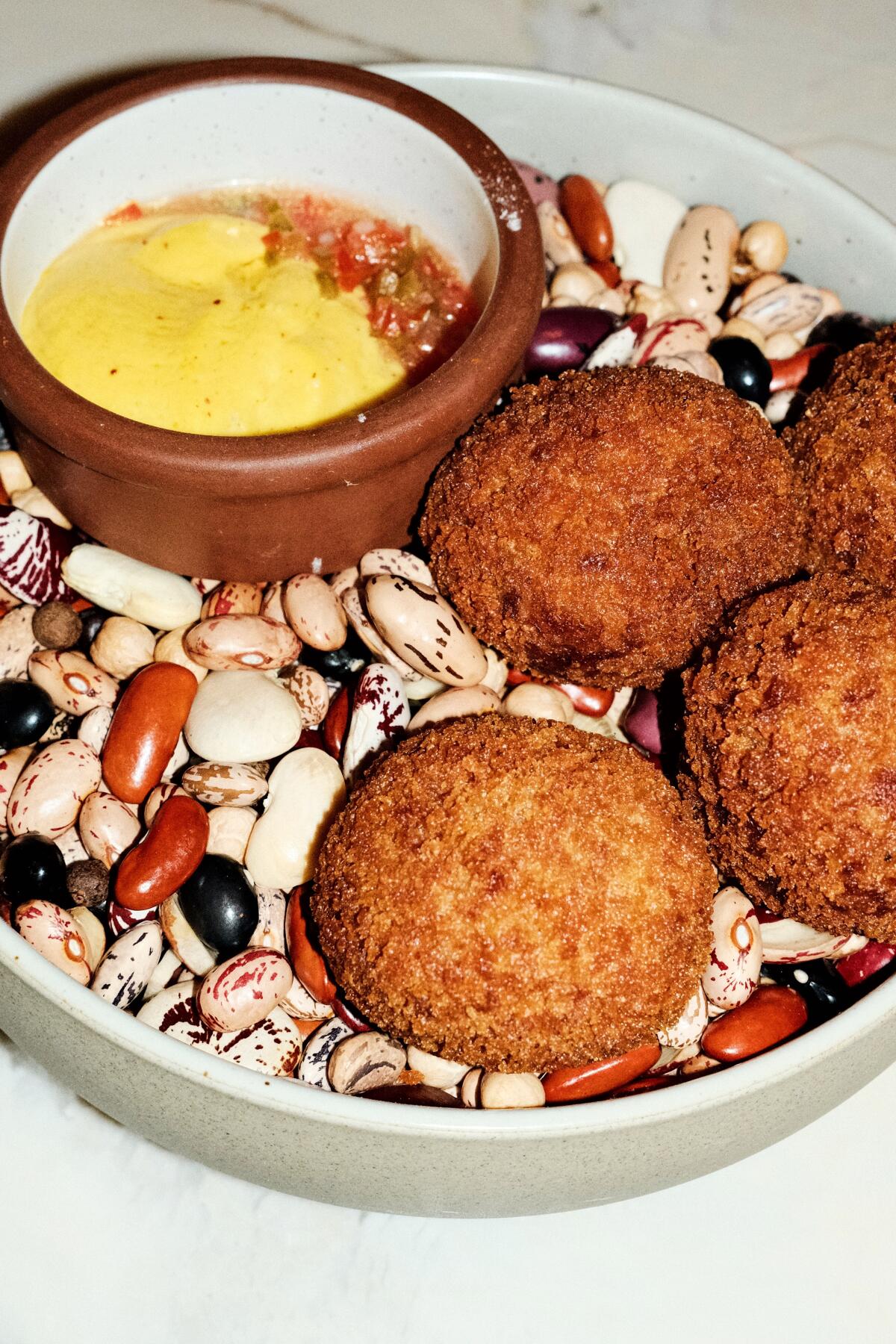‘Stop undervaluing our food.’ New Fairfax restaurant showcases Afro-Caribbean fine dining

- Share via
- Stylish new restaurant Lucia brings Afro-Caribbean comfort classics to fine dining heights along Fairfax Avenue.
- “I truly believe that our culture needs something like this,” said executive chef Adrian Forte.
At one of the city’s most anticipated new restaurants, diners feast on Wagyu-stuffed Jamaican patties and saltfish-and-fig croquettes while seated in sculptural, shell-like booths. A showstopping flower-like art installation crowns the bar at the center of the modern Afro-Caribbean restaurant. Jerk-spiced tomahawk steaks and sorrel-dusted plantains make their way out to the tables while a DJ spins music late into the night. Lucia wants to take island flavors — and Fairfax— to new heights.
“I knew how diverse and how flavorful and how impactful this cuisine could be if executed in this modern way that Adrian [Forte] has taken it to,” said owner Sam Jordan. “It came from a love of the food and an opportunity to do something different in L.A.”
In chef Forte’s Guyanese-style oxtail pepper pot — a dish that takes three days to make — the meat is coated in a house-ground spice blend and smoked over Jamaican pimento wood, then braised and served with a sauce reduced with cassareep. The tender fried chicken is brined in coconut milk and dabbed with fermented chili aioli. Pepper shrimp toast, a nod to Jamaica’s cultural melting pot, blends the ubiquitous fermented-pepper shrimp street food with the fried Chinese classic.

“I truly believe that our culture needs something like this,” Forte said. “Other cultures have all these different restaurants that are doing [their cuisines] at a high level and teaching cooks how to make this food. But we don’t have that in our culture, so that was very important for me, and very purposeful.”
A large reason for this, he said, is value perception. Why might some diners pay $40 or $50 for a bowl of pasta but not the oxtails that take three days to make? Caribbean cuisine, he said, can and should exist across a range of price points.
“I was very adamant about wanting to do this project ... mainly just for the culture so they can see that it’s possible, and they could see the perceived value, and we could stop undervaluing ourselves and our food,” he said.

Another reason Forte believes Caribbean cuisine isn’t often attempted in fine dining is accessibility of ingredients.
Multiple chefs of L.A. Caribbean restaurants told Forte they couldn’t find the fresh leafy greens required to make callaloo, and thus ordered it canned. But Forte noticed that many Southern California farmers use sweet potato and taro leaves as compost or as feed for livestock; now he buys it fresh from the farmers and serves it as creamed callaloo with grilled snapper and a coconut butter sauce.
When hunting for sorrel, he heads to Latin markets for hibiscus. When looking for boniato, or Caribbean sweet potato, he easily finds Japanese sweet potato. He purchases plantains from a Vietnamese grocer.
“I’m not necessarily missing any specific ingredients,” Forte said, “because of the interconnectedness of what we do as a whole. The diaspora is so vast, and we have all these synergies with different cultures that people don’t even realize.”
Spanning island nations and countries in Central and South America, Caribbean cuisine pulls influence from West African, East Indian, indigenous and Latin American culinary traditions.
Late-night service focuses on his small bites and the drinks overseen by beverage director Melina Meza (formerly of Level8, Boujis Group), which include an okra martini, a tamarind Collins and an oxtail old-fashioned. But Forte is also planning a new, Caribbean-inspired raw bar program, which he also expects to serve late into the evening.
The Jamaica-born chef has deep culinary roots; his parents met at their own parents’ shared restaurant. Forte spent years of his childhood and adolescence in their kitchens, and when his father immigrated to Canada, Forte spent years traveling between, dining and cooking in both countries. He participated in season eight of “Top Chef Canada” — as the series’ first Black contestant — and helped launch multiple restaurants there.
When he met Jordan, Forte was working as a private chef in Jamaica. But Jordan’s vision for Lucia lured the chef and “Yawd” cookbook author to Los Angeles.

After years spent investing in other people’s restaurants in L.A. and the Bay Area, California-born Jordan wanted to build a business of his own and drew on his travels in the Caribbean to do it.
When Jordan moved to L.A. in 2016 he found a bustling Fairfax filled with art, street style and tastemakers. The pandemic closed multiple storefronts along the iconic stretch, but the restaurateur hopes that Lucia — which opened in the former Black Star Burger space — can help spur revitalization on the street.
He and design firm Preen pulled from the Caribbean’s flora and fauna for the interior, calling on artist Guerin Swing to hand-cast the rows of “shell booths” and the towering, flower-like bar sculpture from concrete.
“The whole place is like a show,” Jordan said. “When you look around you see the big flowers in the center, you see the shell booths; the back dining room area is beautiful with the mirrors, everything. A big part of the food and the cultures that inspire our restaurant is the idea that we’re not we’re not trying to rush anyone out. We want people to get comfortable, to order food, order drinks, hang out, listen to the music. It’s really like a whole immersive experience.”
Lucia is open Wednesday to Sunday from 6 p.m. to midnight at 351 N. Fairfax Ave., Los Angeles, (213) 800-0048, luciala.com
More to Read
Eat your way across L.A.
Get our weekly Tasting Notes newsletter for reviews, news and more.
You may occasionally receive promotional content from the Los Angeles Times.












